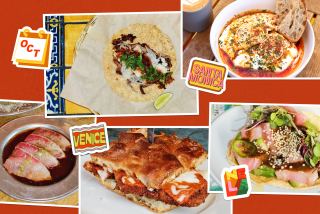L.A. stories hidden in menus, from tiki kitsch to Ma Maison
The special collections archive at the Los Angeles Public Library contains roughly 9,000 menus — from rare 19th century banquet menus boasting a “saddle of Canadian mutton” to the informal paper sheets produced by L.A.’s countless neighborhood joints, such as the Mexican Revolution-themed menu from the longtime Boyle Heights diner El Tepeyac.
To go through all of these menus would take years.
Thankfully, someone has done the dirty work for us: writer, critic and USC communications professor Josh Kun has sorted through the pile with the help of a group of USC students, in search of historic and visual gems.
Their findings are now part of the exhibition, “To Live and Dine in L.A.,” which opens at the Los Angeles Central Library on Saturday, in partnership with the Library Foundation of Los Angeles. The show has dozens of original specimens from the collection: Polynesian throwbacks full of vintage cocktails, whimsically shaped lists in the shape of chickens, bears and logs, and even a menu designed by painter David Hockney (for Ma Maison in the late 1980s, one of the grande dames of California nouvelle cuisine).
The menus also have stories to tell.
“The question for me was how do menus get us to think about social issues, racial issues, gender issues?” Kun says. “How do you take a collection like this and display its historical value, but look at it through the lens of contemporary issues?”
The result is an exhibition that looks as much at the history of Los Angeles as it does menus.
This includes an examination of racialized depictions of Asians and Mexicans, the Polynesian craze that was less Polynesian than it was a polyglot amalgam of Asian and American food styles and iconography, and restaurants that were iconic for their architecture — as well as being the site of important African American civil rights protests.
Included in the mix will be installations by artists such as Karla Diaz, Haruko Tanaka and the collective Fallen Fruit, which riffs on the social, cultural and economic ramifications of food.
Moreover, the entire installation design — which has transformed the Getty Gallery at the Central Library into a wild green hybrid restaurant/exhibition space, complete with rotating bakery display case — was designed by wHY, the L.A.-based architectural firm that created the displays for the L.A. County Museum of Art’s dramatic samurai armor exhibition last fall. (In other words, this is going to look good.)
There is an accompanying book, “To Live and Dine in L.A.,” written and edited by Kun, with an introduction by chef Roy Choi (of Kogi fame) and published by Angel City Press. It features a number of guest essays. (Among them: a piece by Times food critic Jonathan Gold on the pioneering Saint Estèphe, known for fusing New World ingredients with continental technique).
For Kun, the show has been a dive into the history of the region as much as it has into his own past. Among the discoveries he made: the bright green menu for Budapest, a Hungarian restaurant that stood on Fairfax Avenue in the 1960s. It’s a restaurant that his immigrant grandfather co-owned.
“I knew that he worked in restaurants, but I didn’t know he co-owned one,” he says. “He was a waiter. The fact that he could be an owner too — that’s a big deal.”
“To Live and Dine in L.A.” opens at the Getty Gallery at the Central Library on Saturday and runs through Nov. 13. Check the website for related events at branch libraries. 630 W. 5th St., downtown Los Angeles, lapl.org.
More to Read
The biggest entertainment stories
Get our big stories about Hollywood, film, television, music, arts, culture and more right in your inbox as soon as they publish.
You may occasionally receive promotional content from the Los Angeles Times.











